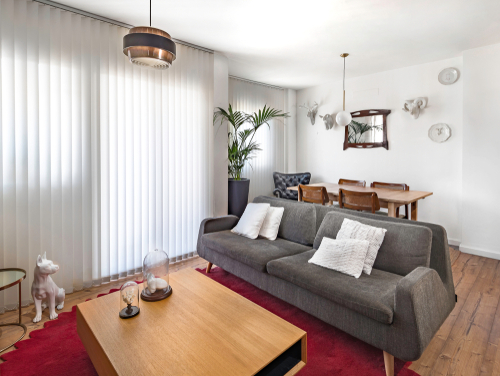It’s 9:00am and you’ve just touched down in sunny Barcelona and arrived at your Airbnb. You open the door and your eyes dart around the room — lots of light, modern furnishing and most importantly, it’s clean! First impressions are good.
You’re buzzing with anticipation of exploring the city, but you’re a bit groggy from the flight. Like magic, you spot some mugs on the kitchen counter. You reach into the kitchen cupboard and viola! Coffee and sugar. Coffee in hand, you take a seat on the sofa and, spotting the wifi code on the coffee table, plug it into your phone and scroll through Instagram. After a few minutes you snap yourself out of your social media daze and jump in the shower. You’re pleased to find shampoo, conditioner and soap waiting for you when you get in and a fresh towel within reach. After drying off, you realise: you forgot your hairdryer. Your heart sinks. You decide to message your host to see if they can help. Within a minute, you get a response: “Under the sink”. Lifesaver.
You might be asking yourself at this point, why have I made you imagine you’re on vacation in Spain when you thought you were supposed to be learning about website design? Well, as it turns out, a well-designed website and a good Airbnb have a lot in common. Stick with me here.
Make a good first impression
When entering a new environment, be it physical or digital, people intuitively form a first impression based mainly on visual stimuli. In fact, in the case of a website, sources suggest this first impression is formed in less than one second. A captivating visual design will get you part of the way to a good first impression (much like the interior design of an apartment), but it’s also important for people to be able to quickly understand where they are and what they can do next. The efficiency with which people navigate their environment has a significant impact on their overall user experience. This is where information architecture comes in.
Importance of information architecture
Information architecture is the structuring of information on a website, app or other product. This includes organising content logically, describing it clearly, and providing routes for people to get to it. When done well, it allows people to easily navigate to content that’s relevant to them through both active (intentional or goal-oriented) and passive (accidental or unplanned) information-seeking. Spotting the WiFi code on the coffee table and the mugs on the countertop were both forms of passive information-seeking because you weren’t actively looking for these items (at least not consciously). On the other hand, locating the coffee and the hair dryer were both active information-seeking activities; you had an item in mind and intentionally sought to locate it. Both websites and homes should be designed to support both behaviours.
As mentioned, good information architecture also includes the logical groupings of items. If the shampoo and conditioner were in two different locations, it would be not only confusing, but a hassle for guests because they’re typically used one after the other. In a similar manner, it was convenient, albeit unexpected, that sugar was placed right next to the coffee so you didn’t have to go looking for it while preparing your drink. Grouping similar items together helps people to efficiently accomplish tasks in both digital and physical environments.
Guided by previous experiences
How did you know where to find coffee in a stranger’s home? How did you even know it existed? The answer to this is two-fold: previous experience (where you expected to find it) and signposting. The mugs on the counter signalled to you coffee was available, and their placement suggested grounds might be found nearby. In the same way, when you’re visiting a website for the first time, you’re guided both by your previous experiences and the information that’s available to you (the content on the page). Harness this knowledge! Most people have used websites similar to yours in the past, and will try to interact with it in a similar way — design with this in mind and follow conventions.
Understand what your users need
From the first moment people enter an Airbnb, they subconsciously create a running total of the positive and negative aspects of their experience. When prompted to review their accommodation at the end of their stay, this score will reflect the sum of all of these experiences. Was it easy to find? Was it clean? Was it stocked with everything they needed? Was the host responsive? The list goes on. Every small interaction accumulates to form the overall user experience. As the “host” of your website, it’s your responsibility to understand what the key touch points of your product or service are in order to anticipate what users (your guests) need before they even ask for it.
Top tips from an Airbnb experience
Here are some tips from the world of Airbnb for designing a website that’s worthy of a 5* review:
- Hire a cleaner – An uncluttered webpage with judicious use of white space will invoke the same feelings as a clean house, putting your users at ease.
- Put some art on the walls – Don’t be scared to share your personality. Although websites should be usable for everyone, it’s less important to have a visual design that’s universally appealing (in fact, it’s impossible).
- Don’t put forks in the bathroom – Somewhat contrary to the last point, follow conventions. People’s expectations of how to use a website will be based on their experiences of using other sites. The key is to be strategic in your decisions on when to follow convention and when to branch out.
- Place the mugs in plain sight – Offer users an indication of what’s available to them through signposting. While you can’t physically tell people, “Hey, look here!”, a good design can do the talking for you.
- Put the WiFi code by the couch – By understanding your users’ context of use, you can surface the information that’s relevant to them at the appropriate times.
- Put the shampoo and conditioner in the same place – Try to get an understanding of how your users mentally group items (through conducting user research) so you can determine the best strategy for organising your website content.
- Hang the towel up by the shower – Always anticipate you’re your users’ next step might be so the flow of moving through your site is never broken.
- Keep your phone handy – Inevitably, there will be times when people require assistance to resolve an issue. Ensure its clear where they can go for support when this happens.
- Leave them a hairdryer – Predict the things that might go wrong in advance so you can arm yourself with a solution (and win the gratitude of your customers).
Learn more
- Training course: User Research Methods & Practice
- Training course: User Testing
- Training course: Designing for the Human Mind






